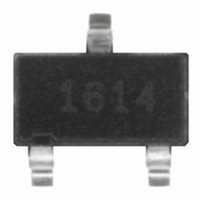US1881ESE Melexis Inc, US1881ESE Datasheet - Page 11

US1881ESE
Manufacturer Part Number
US1881ESE
Description
IC LATCH CMOS MP TSOT23-3
Manufacturer
Melexis Inc
Type
Bipolar Latchr
Specifications of US1881ESE
Sensing Range
9.5mT Trip, -9.5mT Release
Voltage - Supply
3.5 V ~ 24 V
Current - Supply
5mA
Current - Output (max)
50mA
Output Type
Digital, Open Drain
Operating Temperature
-40°C ~ 85°C
Package / Case
TSOT-23-3, TSOT-3
Lead Free Status / RoHS Status
Lead free / RoHS Compliant
Features
-
Other names
US1881ESETR
Evolution of Magnetics
Modern society would not exist in its present form if not for the development of permanent magnet technology.
Many of the major advances in the last century can be traced to the development of yet better grades of magnet
materials. The earliest magnets were naturally occurring iron ore chunks mostly originating in Magnesia hence
the name magnes. We now know these materials to be Fe3O4, a form of magnetite. Their unique properties were
considered to be supernatural. Compasses based on these magnes were called lodestones after the lodestar or
guidestar. They were highly prized by the early sailing captains.
The Pioneers
More sophisticated magnets did not come into use until the 15th century when William Gilbert made scientific
studies of magnets and published the results. He found that heating iron bars and allowing them to cool while
aligned to the earth's field would create a stronger magnet than a naturally occurring lodestone. His magnet tech-
nology however remained a curiosity until the 19th century when Hans Christian Oersted developed the idea
that electricity and magnetism were related. He was the first to determine that magnetic fields surround a current
carrying wire. It would require the development of atomic particle theories before scientific explanations of per-
manent magnets made further advances. The practical applications for magnets continued throughout the 19th
century.
Magnetism in a solid object seems to defy rational explanation. The magnetism is developed in a manner simi-
lar to electrons moving through a coil of wire, magnetic fields are created by electrons in motion around the atom -
ic nucleus. This nuclear model of an atom with electrons spinning in orbit around a nucleus provides a source of
charges in motion. In most materials however, the number of electrons moving in one direction equals that mov-
ing oppositely and hence their magnet fields cancel. This results in no overall magnetic field for the material. It
takes many electrons spinning in the same direction to generate a measurable field. Unfortunately there are kinet-
ic forces at work causing atoms to constantly vibrate and rotate resulting in random alignment. The higher the
temperature the more kinetic energy and the more difficult it is to maintain alignment. Fortunately soldsme mate-
rials exhibit an electrostatic property known as exchange interaction which serves to maintain parallel alignment
of groups of atoms. This force only works over short distances amounting to a few million billion atoms. This
may sound like a large quantity but on an atomic scale it is a relatively small amount. These groups are known
as dipoles and are the fundamental building blocks that determine the properties and behavior of permanent mag-
net.
Relative Magnetic Properties
Magnets and magnetic materials are classified by many terms which describe many different properties, some
of which are explained and used in this book. Perhaps the most commonly asked question about a magnet is
“How strong is it?” Although this can lead to a complex explanation, Figure 9 is an excellent guide to the rela-
tive strength of magnetic forces, from strongest magnetic forces known such as solar flares to the nearly unde-
tectable magnetic signals passing through the neuro network of our bodies.
The Hysteresis Curve
A solid block of magnetic material is composed of multiple dipoles wherein the alignment of all of the dipoles
results in a constant field of maximum value. This maximum field attainable is known as the saturation field. This
condition is obtained by placing a sample of material in a sufficiently strong electromagnetic field and increas-
ing the electric current through the magnetizing coil. As the samples dipoles begin to align a function for the rela-
tionship between the magnetizing field and the field in the sample becomes apparent. In the low field levels the
slope of the curve is very steep.
This relates to the rapid alignment with the magnetizing field of a majority of dipoles. As current levels increase

















